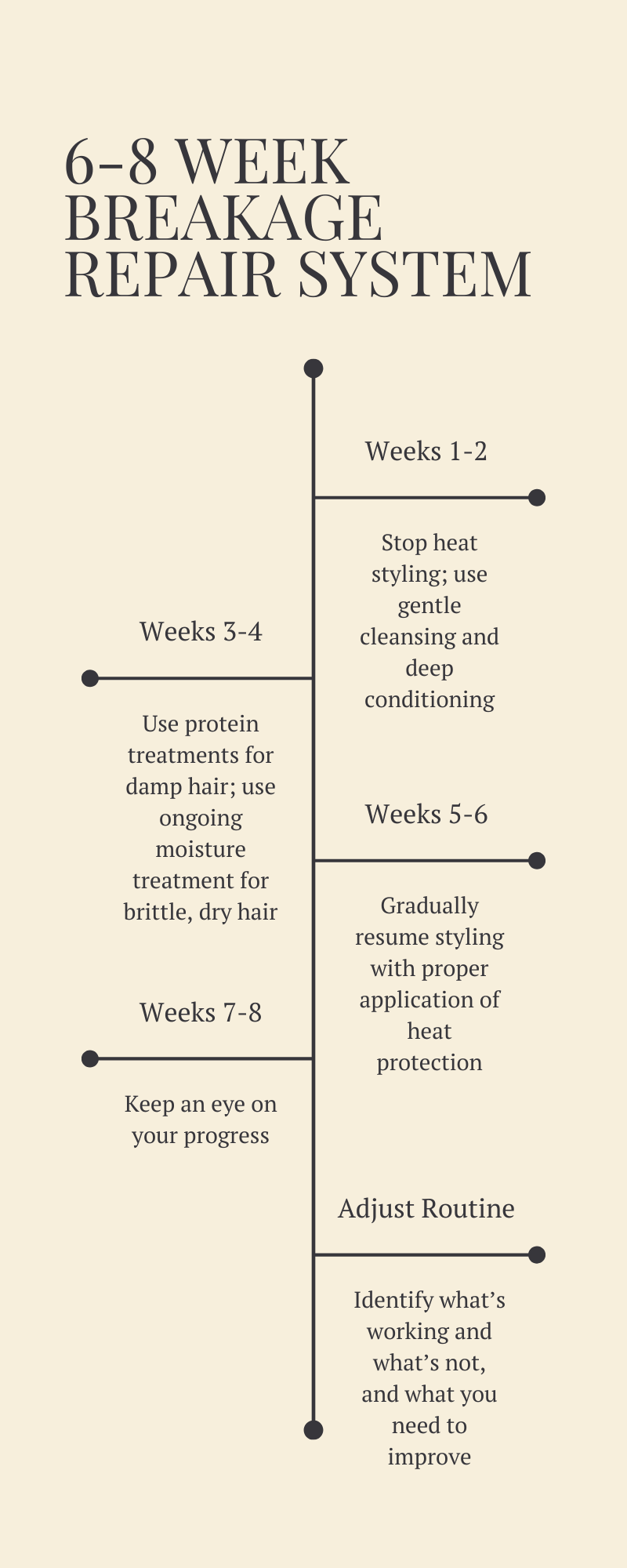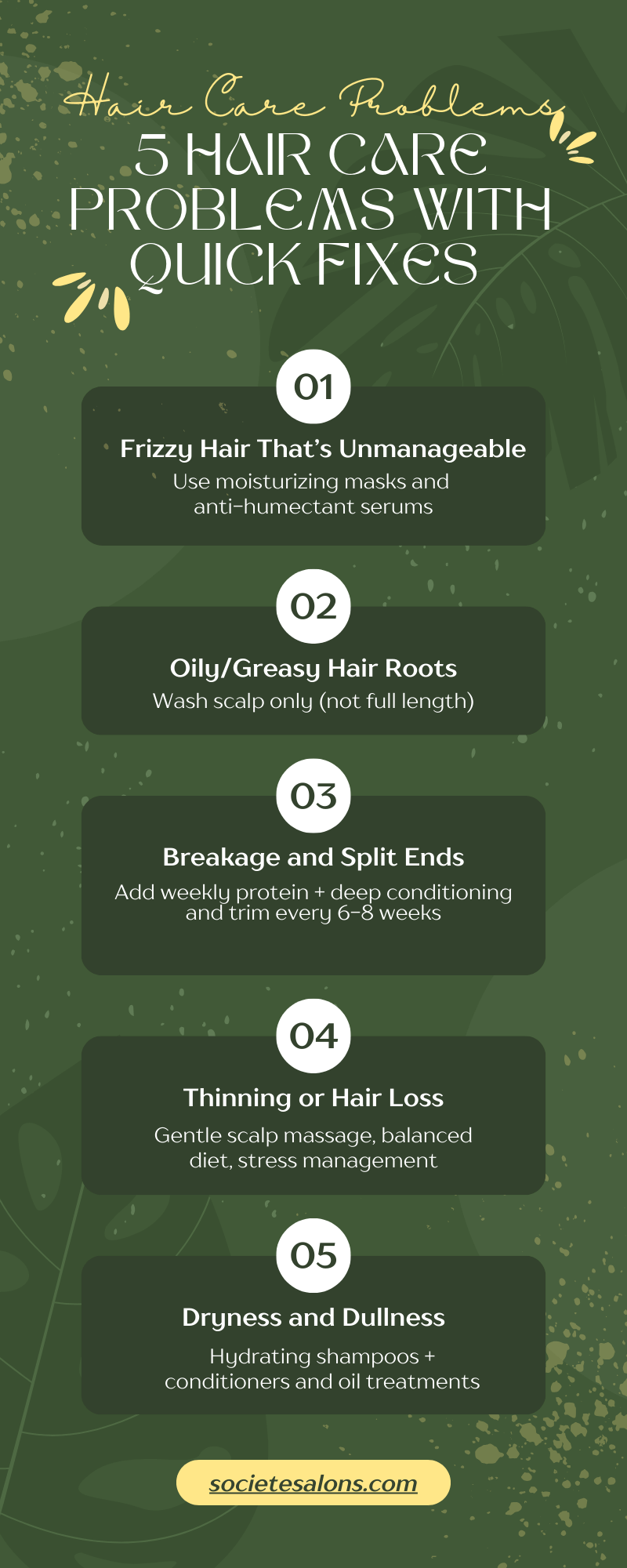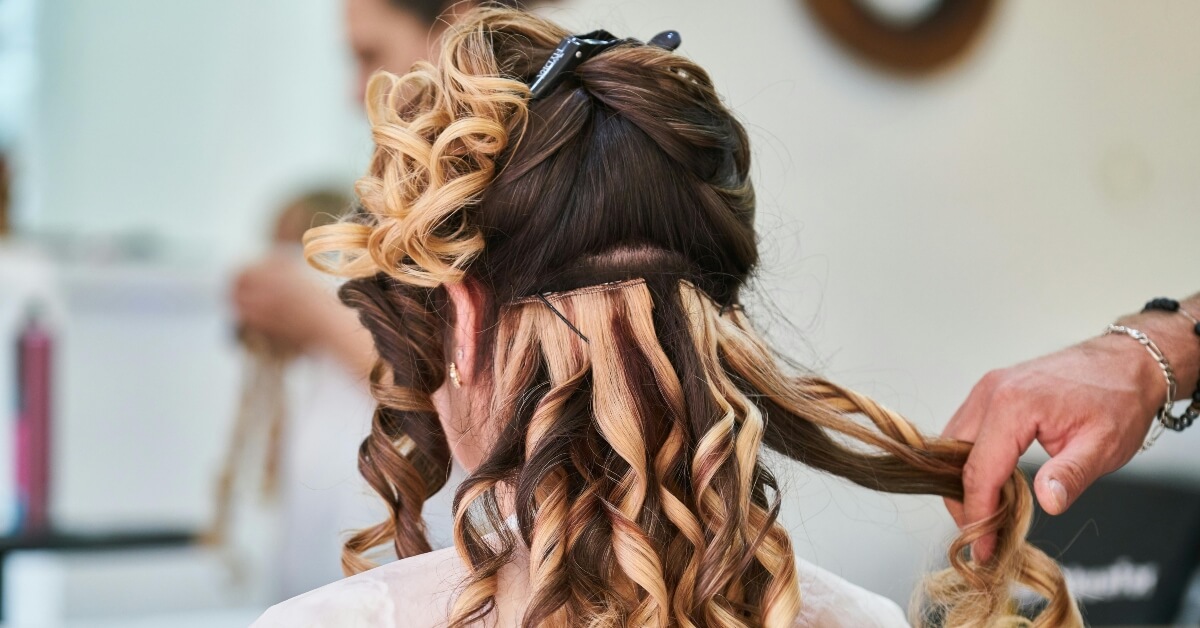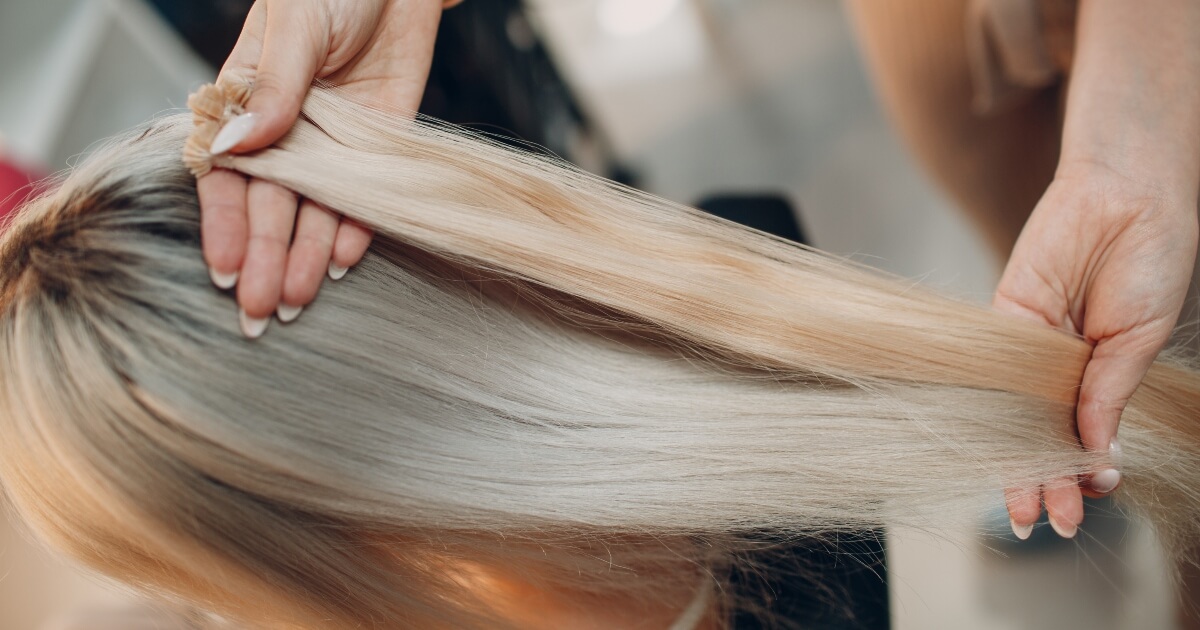Are you tired of following generic hair care advice that doesn’t work for you? Have you tried a lot of products and regiments that didn’t work?
The thing with hair care is that what works for your best friend can be completely wrong for you. Your hair is an individual with its own character, needs and problems that require an individual solution.
Societe Salon’s hair care guide is unique because it teaches you about your hair’s individual needs and leads you to develop a routine which works within your lifestyle, budget and goals. No more guesswork or money wasted on products that don’t work.
Need more assistance with your hair, or are you looking to try extensions, a new color or a new style? Book your appointment at Societe Salon today. Our elite hair stylists are dedicated to delivering beautiful hair.
The First Step is Determining What You Are Working With
Before you can even create a good hair regimen, you must first understand what you are working with as far as your hair type is concerned. Once you understand how your hair behaves, you can work with it and not against it.
Getting Familiar with Your Hair’s DNA
There are four main types of hair, with subcategories for a more specific classification:
Type 1 (Straight Hair):
- 1A: Thin, fine, and very straight
- 1B: Medium with little volume
- 1C: Thicker with wavy ends
Type 2 (Wavy Hair):
- 2A: Loose, barely-there waves
- 2B: Well-defined waves with some frizz
- 2C: Deep waves with stiff frizz and volume
Type 3 (Curly Hair):
- 3A: Loose, large curls
- 3B: Springy ringlets
- 3C: Tight corkscrew coils
Type 4 (Coily/Kinky Hair):
- 4A: Loose coils with visible curl pattern
- 4B: Z-pattern coils with decreased definition
- 4C: Tightly coiled hair with minimal definition
But knowing your hair type is just the beginning. You also need to know the porosity of your hair, or how it absorbs and retains moisture.
Testing Your Hair’s Porosity at Home
The water test is easy and provides basic information about your hair structure. Gently pull some clean hairs from your brush and drop them into a glass of water.
If your hair floats, you have low porosity hair with tightly closed cuticles that repel moisture. If it sinks slowly, you have normal porosity. If it sinks quickly, you have high porosity hair with damaged or lifted cuticles that absorb moisture quickly but also lose moisture quickly.
And lastly, there’s the float test:
- Slide your fingers along a strand of hair from root to tip.
- If it slides easily, you have low porosity.
- If it’s slightly rough or catches on something, you have normal to high porosity.
Why Density vs. Thickness Matters
Most confuse hair density with thickness, but they’re completely different and affect your hair care needs differently.
Density of hair refers to how many individual hairs you have per square inch of scalp:
- Part a section of hair and look at your scalp.
- If you can easily see your scalp, you have low density.
- If it is barely visible, you have medium density.
- If you barely notice your scalp, you have high density.
Hair thickness is the diameter of one strand:
- Pick up one strand between your fingers and roll it.
- If you can hardly feel it, you have fine hair.
- If you can feel it noticeably, you have medium thickness.
- If you feel it thick and wire-like, you have coarse hair.
This distinction is crucial because fine, high-density hair needs lightweight products that will not weigh it down, while coarse, low-density hair can handle more rich products.
Testing Your Hair Elasticity

The wet hair stretch test will indicate the amount of damage your hair has suffered. Use a damp strand and gently stretch it. Healthy hair will stretch to approximately 50% of its length before it snaps and then revert to its original length.
If it breaks immediately, it’s over-processed or severely damaged. If it stretches but not to the original shape, your hair lacks protein. If it will not stretch much at all, it may be too dry or have too much protein.
Beyond Basic Types: Your Hair’s Personality
Your hair not only has a type, it has behavioral tendencies that change based on many factors.
Observe how your hair responds to different seasons:
- Does your hair get oilier during summer?
- Frizzy in winter?
- Some hair will become more porous with humidity, while other hair textures will dry out and be unmanageable.
Notice how your hair responds to weather and humidity:
- Dry weather can cause your straight hair to be limp or curly hair to be frizzy.
- High humidity can make your hair be limp or curly hair to be frizzy.
Your history of chemical processing also affects the way your hair currently acts. Older coloring, perming, or relaxing has left behind weak areas that require special care, even years after they were done.
Changes due to age are normal and unavoidable. Hair usually gets finer and more brittle with age, oil production diminishes, and gray hair has a softer texture that may need frequent adjustments.
We know your hair has a mind of its own at Societe Salon. We never forget that when you leave your hair in our hands.
Book your appointment today.
The Science-Backed Hair Care Routine
Now that you know your hair’s personality, it’s time to develop a routine that works with your hair’s nature rather than against it.
The Non-Negotiable Steps Every Hair Type Needs
All effective hair treatments start with preparation.
- Pre-shampoo rituals like scalp massage cause circulation and loosen residue before shampooing. Dry, damaged hair can be pre-shampooed with an oil treatment to prevent over-drying.
- Massage oil from mid-length to the ends, but not on the scalp if very dry. This creates a barrier so tough detergents won’t take too much moisture away.
- Strategic washing is where most people do get it wrong. The idea that washing every day kills your hair isn’t necessarily the case for everyone – it depends on your scalp’s sebum production and lifestyle.
- Oily scalps may require daily washing, but dry scalps may be okay with washing every 3-4 days.
- Most importantly, apply shampoo to your scalp first, not your hair length. Your scalp is where the oil is being created and grime is accumulating, so that’s where it needs to be cleaned.
The mid-to-ends conditioning rule is important because that is where your hair is oldest and most damaged. Your scalp doesn’t need additional conditioning. It actually makes fine hair look greasy and flat its volume if left behind.
UV light, pillowcase rubbing, and heat styling all accumulate damage. Simple things like sleeping on a silk pillowcase, applying heat protectant before styling, and wearing a hat when you go outside into the bright sun all make a huge difference in the long run.
Adjusting Your Routine to Life Stage
Your hair’s needs shift as you age, and your routine must shift along with it.
Your Teens and 20s
It is when you learn to develop nice habits that will not hurt in the long run. Be careful with gentle washing, conditioning process, and styling without damaging your locks. It is also the time when you may attempt dyeing or chemically treating your hair, so learning how to care for chemically treated hair right is essential.
30s to 40s
This decade is about preventing initial damage and managing more life stress that affects hair health. You can find your hair a little less strong than it used to be, so weekly treatments are a must. This is also an age where hormonal imbalance as a result of pregnancy or work-related stress could influence hair growth and texture.
Your 50s and Beyond
At this stage, you need to adapt to hormonal fluctuations that affect hair thickness, oil level and growth cycle. Thin hair and texture change are likely to result from menopause, so your routine could involve regular repetition of protein treatments and products for older hair.
The Weekly and Monthly Maintenance Calendar
Perfection is not as appealing as habit, but some treatments are best on a schedule.
Deep treatments are necessary on week-old damaged hair, every other week for healthy hair, and every four weeks for low-maintenance hair. You don’t want to overdo it, and too much protein or moisture will damage hair.
Scalp detox needs to be done based on product buildup and lifestyle. If you have a lot of styling products in your hair or reside in a dirty city, then you will need to use monthly clarifying treatments, which strip away buildup that regular shampoo cannot deal with.
Professional trims have to be based on your hair growth rate and your styling requirements. Everyone has to get a trim every 6-8 weeks, but this is subjective based on hair health, length requirements, and styling frequency.
Hair Type-Specific Solutions That Really Work
Generic advice doesn’t work because different hair types have completely different requirements and issues. This is what really works for each type.
Straight Hair (Type 1): Defending Against the Grease War
Straight hair takes less time to get oil and buildup because there is nothing to cover it up from. Your biggest obstacles are keeping oil production in check and giving volume without harming it.
Getting regulation of oil production under control begins with knowing that over-washing makes oiliness worse:
- Even if you wash daily and your hair is greasy in the evenings, you might be depriving your scalp and having it produce additional oil to compensate for it.
- Gradually try to stretch wash days. If you wash daily, attempt every other day for a week, then every other two days. Your scalp will adapt to its own oil in due time.
- Dry shampoo is your BFF, but use it sparingly. Use it on clean hair before bed to absorb nighttime oil production, not as a desperate temporary fix on already oily hair.
Straight-hair volumizing tips require light formulations that won’t weigh the hair down. Mousses work more effectively than creams at adding volume, and root-lifting sprays must be used on dampened hair to achieve maximum effect.
The upside-down blow-drying technique provides volume to the roots but keeping the hair too straight in one direction, which will cause breakage.
Heat treatment of fine straight hair is all about using less heat and more heat shielding. Fine hair cannot handle the same temperature as coarse thick hair. Flat irons need to be used below 300°F and blow dryers on a medium heat setting.
Wavy Hair (Type 2): How to Restyle Your Natural Texture
Wavy hair must be straightened or battled, not bettered. It is a matter of learning to live with your own natural texture and minimizing frizz and definition.
The Scrunching Method
The scrunching technique is effective if executed properly. Use leave-in conditioner and styling cream on very wet hair and scrunch up later to help with curl formation. The most common error is scrunching dry or only slightly damp hair, doing no good except for producing frizz.
Product layering for wavy hair also has its order:
- Leave-in conditioner
- Curl cream or gel
- Sealing with serum or light oil at the end.
- All of them need to be applied to soaking wet hair and evenly spread before the next layer is added.
Amount matters too. Wavy hair will usually need less product than curly hair but more than straight hair. Start with small amounts and increase a little at a time.
Sleeping habits to preserve waves like “plopping” onto a microfiber towel or cotton shirt, sleeping on a satin or silk pillow cover, and softly braiding wet hair at night for extra waves.
Curly Hair (Type 3): The Science of Moisture and Definition
The way in which curly hair naturally curls tends to dehydrate it due to the fact that the oil from the scalp is not able to freely move along the hair shaft. Your focus is curl definition and managing moisture.
The LOC system (Leave-in, Oil, Cream) is suitable for the majority of curly hair types, but others like LCO (Leave-in, Cream, Oil) or LC (Leave-in, Cream) separately.
Here is how to make the most out of it:
- Use leave-in conditioner on soaking wet hair
- Use a small amount of oil to lock in the moisture
- Define using curl cream and seal
- The secret lies in applying small amounts of each product and first pre-saturating hair with water.
Day 2-3 curl refresher saves time without compromising definition. Combine water and a little leave-in conditioner in a spray bottle. Lightly spray on sections of hair, scrunch to re-establish curl pattern, and air-dry or diffuse using low heat.
Diffusing versus air drying are both pros and cons. Air drying takes longer but gives more definition to curls. Diffusing is faster but can result in frizz when done incorrectly.
When diffusing, keep low heat and low speed, and don’t move the diffuser around much. Cup hair sections in the diffuser bowl and remain stationary for 30-60 seconds before releasing to proceed to the next section.
Coily/Kinky Hair (Type 4): All About Retention and Growth
Type 4 hair is the most breakage-prone and weakest of all, so your regimen needs to be about retention of length and moisture more than about changing styles all the time.
Rotating protective styles helps avoid breakage that occurs from constant manipulation. Alternate low-manipulation styles like twist-outs, braid-outs, and protective styles like braids or twists.
The secret is not to leave protective styles in for that long. Even protective styles will break hair out if left in for months without updating.
Moisture and protein balance is most important to Type 4 hair because it naturally lacks protein as a result of its texture. Apply protein treatments when the hair is mushy and overstretched and deep moisturizing treatments when the hair is dry and brittle.
Understand how your hair reacts to products. If a protein treatment dehydrates or wears out your hair, you require moisture. If moisturizing treatments leave your hair damp or limp, you require protein.
Length retention methods are protective styling, fragile detangling when wet with large amounts of conditioner, resting on satin or silk, and reducing heat styling.
Daily dusting (cutting only the damaged ends) keeps split ends from traveling up the hair shaft and breaking further.
Solving Your Biggest Hair Challenges
When your routine no longer works or new issues crop up, it’s time to get your detective hat on and determine what’s really happening.
The Root Cause Detective Work
Extreme change in hair typically does make sense after you know what to expect. Varying texture, oil level, or handling typically indicates:
- Medication, pregnancy, or menopause-related hormonal imbalance
- Change in water source with different minerals
- Change of season for temperature and humidity
- Product buildup due to change of routines
- Higher stress that impacts the hair growth cycles
Damage and natural texture are often mistaken for each other. Real damage from chemical processing or heat styling results in permanent hair structure change. Natural texture characteristics such as cowlicks, varying curl patterns on the head, or combination thickness are genetic and cannot be “fixed.”
Being aware of the difference keeps you from attempting to fix things that are natural differences, not issues to repair.
Professional vs. home remedy use will depend on type and degree of problem. Professional evaluation is indicated in acute hair loss, irritation of the scalp, or drastic change in texture. Slow change in manageability or appearance can be addressed with minor adjustments.
Challenge-Specific Action Plans
Anti-frizz product just half the story. True frizz control starts with healthy moisture balance and good hair care.
Most frequent causes of frizz are:
- Dry hair that’s trying to absorb moisture from the environment
- Bent cuticles that can’t lie flat
- Rough manipulation that raises the cuticle layer
- drying alcohols in formulas
Fight frizz with moisturizing products, prepping hair for moisture in humid environments with anti-humectant serums, and replacing pillowcases with silk and towels with microfiber.
Thinning hair should be treated as early as possible. The earlier thinning is addressed, the more can be done.
Visible indicators to be aware of are parted opened lines, more hair on your brush, and thickness variations of ponytails. These can indicate:
Androgenic alopecia (pattern loss)
- Stress or hormonal imbalance-induced telogen effluvium
- Traction alopecia caused by tight hairstyles
- Nutritional deficiency
Early treatments include scalp massage for the benefit of improving circulation, smooth manipulation in order to prevent mechanical damage, and treatments containing active agents like caffeine or niacinamide that foster scalp health.
Reparation of breakage has to be achieved in a system lasting between 6-8 weeks. The regimen is:
- Weeks 1-2: Discontinue heat styling and chemical processing completely. Gentle cleansing and deep conditioning become priorities.
- Weeks 3-4: Add protein treatments if hair is damp, or ongoing moisture treatments if the hair is brittle and dry.
- Weeks 5-6: Gradually resume styling with proper heat protection again.
- Weeks 7-8: Monitor progress and adjust routine accordingly.
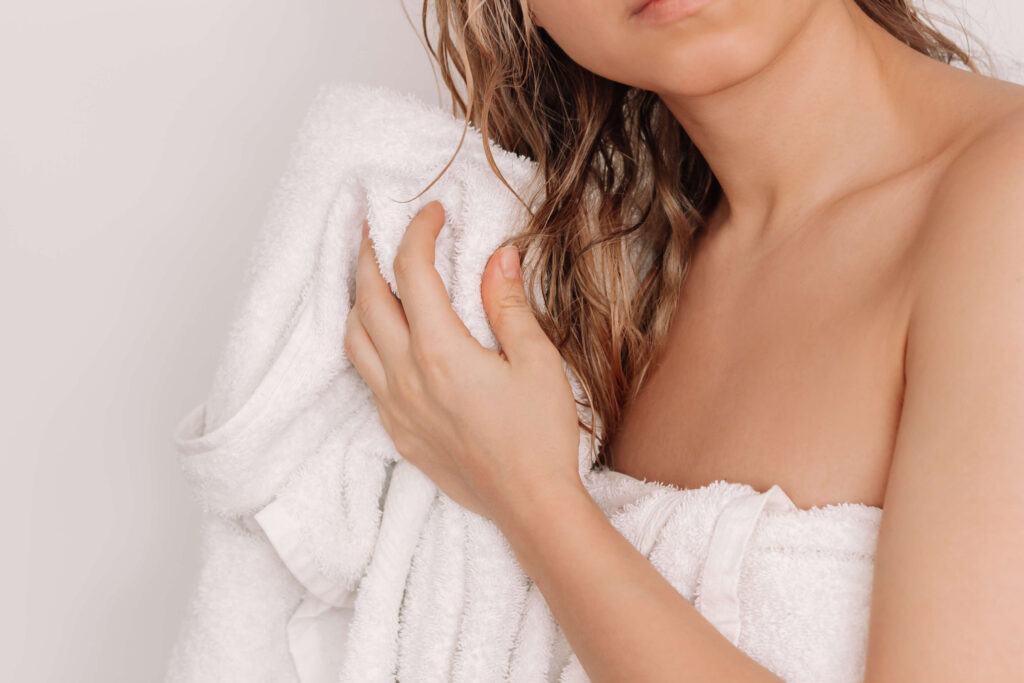
Scalp conditions like dermatitis, buildup, and sensitivity often masquerade as hair conditions. Itchiness of the scalp with flakiness prevents hair growth and appears.
Seborrheic dermatitis causes yellow, oily scales and is treated with antifungal ingredients like ketoconazole or zinc pyrithione. Product buildup causes tightenings, scratching sensations and requires clarifying treatments. Product allergic contact dermatitis causes redness and inflammation and requires identification and elimination of offending ingredients.
Color repair without cutting length requires time and proper products. Over-processed color-treated hair must be replenished with protein to restore structure and moisture to keep it flexible.
Use color-safe products, add protein treatments weekly, protect against UV damage with leave-in products containing UV filters, and minimize heat styling while hair recovers.
Professional Services vs. DIY: How to Make Smart Investment Decisions
Knowing when to spend money on professional services and when doing it yourself will do just as well will save you hundreds of dollars with the assurance that you get what you need.
When to Indulge in Salon Services
- Chemical processes like color, perms, and relaxers almost always require professional expertise.
- Chemistry is complex and prone to mistake, and a mistake can cause severe damage or chemical burns.
Professional colorists understand how different types and conditions of hair affect coloring results. They are able to assess:
- Your hair’s bleach ability
- The correct developer strength
- and design personalized colors
Upmarket treatments like Keratin smoothing, Olaplex, or any repair treatment for bonds require professional-grade ingredients and protocols out of reach to be performed at home.
High-end treatments commonly include:
- Professional application techniques
- Processing
- Professional-as-taught-aftercare
Exact face-framing layers, drastic length alterations, or repair work are enhanced by professional know-how and experience.
A good stylist can look at your lifestyle, hair growth pattern, and face shape to make a cut that co-exists with your natural hair texture.
DIY Wins That Save Money
Home treatments are as effective as salon treatments when executed properly and on a regular basis.
- Home deep conditioning masks, protein treatments, and hot oil treatments will be just as effective at home if you have a good product.
- The most important is doing as instructed exactly and repetition when using.
- Most home treatments are enhanced by heat, so using with a hair steamer or warm cloth will enhance effectiveness.
Maintenance methods between appointments will make your hair appear fresh longer. Becoming skilled at doing these things can maximize time between salon visits:
- Trim split ends yourself
- Recharge your color with gloss treatments
- Maintain shape of your cut
Worthwhile investments are an ionic blow dryer, a temperature-adjustable ceramic or tourmaline flat iron, and professional brushes specifically designed for your hair type.
They work better and will outlast the equivalent at the drugstore and are completely worth the initial investment.
Cost-Benefit Analysis Format
Assessing actual cost is to look beyond initial cost to analyze longevity and result.
- A 12-week salon color treatment that is $200 calculates out to $17 per week.
- A 4-week touch-up on a $15 box color that must be professionally corrected costs more over time.
ROI for professional treatments depends on your hair desires and maintenance as well. If you are trying to grow out your hair, investing in professional cuts and treatments that prevent it from breaking is an investment worth making. If you don’t feel like going to work on maintenance, do-it-yourself will be more economical.
Having good rapport with your stylists means you get more done and pay less overall. Long-time regulars can receive priority booking, VIP service, and even discount pricing for being a regular.
The Complete Product Choice Guide
Navigating the vast hair product world is a whole lot easier when you understand which ingredients really deliver and what’s merely a fad.
Ingredient Awareness
Active ingredients target specific hair issues with proven results:
- For moisture: Hyaluronic acid, glycerin, and ceramides trap water inside the hair. Argan, jojoba, and coconut oils provide oiling and protection.
- For protein: Hydrolyzed keratin, silk protein, and wheat proteins mend damaged portions of the hair shaft temporarily, causing strength and elasticity to improve.
- For scalp health: Salicylic acid dislodges and removes dead skin cells, niacinamide stimulates blood flow, and tea tree oil is antiseptic.
- Color protection: UV blockers, vitamin E antioxidants, and sulfate-free cleansers safeguard color brightness.
Ingredients to avoid are sulfates that are too harsh on dry or color-treated hair, drying alcohols like denatured alcohol, which cause brittleness, and heavy silicones, which gradually accumulate in the hair.
Marketing fluff vs. science fact aren’t usually synonymous. Terms like “repair” and “restore” are misnominations since hair is dead tissue that can’t actually be repaired but only temporarily improved in texture and appearance.
Look for the names of actual ingredients, not catchall phrases, and keep in mind that expensive doesn’t necessarily mean better.
Stocking Your Product Pantry
A few essentials everyone needs are:
- A shampoo for your scalp type
- A porosity conditioner
- A thermal protector for any heat styling
- A weekly repair treatment to make
Better quality products for specific application may include leave-in for added protection, styling for your style, and specialty treatments for most issues such as thinning or damage.
Seasonal product changes help offset environmental changes. Thicker products work better with humid summery weather, and lighter products handle dry winter weather.
Travel essentials make everyday routine possible while traveling. Keep to your routine and avoid new items on travel days.
Budget-Friendly vs. Luxury: What’s Worth the Splurge
High-end vs. cheap gem finds beyond the high-end market
- Low-cost sulfate-free shampoos
- Simple conditioners without overwhelming fragrance
- Simple heat protectants with active ingredients.
More expensive products that are worth it can contain higher levels of active ingredients, more sophisticated delivery systems, or newer preparations that can’t be made cheaper.
Home care with home products is inexpensive and convenient. Coconut oil masks, apple cider vinegar rinses, and egg protein treatments use substances you might already have at home.
Environmental Factors and Lifestyle Integration
Your environment and diet play a huge part in how healthy your hair is and what it looks like, often even more than products you put on it.
Seasonal Hair Care Changes
Winter survival tips address dry indoor air, cold winds, and hat-on-problems.
- Use more intense moisturizing treatments
- Protect hair from static with anti-static sprays
- Employ hat-friendly hairstyles instead of fighting them
Summer damage prevention involves:
- Protection from the sun
- Chlorine damage
- Over-washing from swimming and sweating
- UV leave-in products for sun protection
- Clarifying shampoos to shampoo out chlorine buildup in hair
- Beach day protective styling maintain healthy hair.
Humidity control varies based on hair type. Straight hair may use anti-humidity serums that prevent the hair from becoming flat, whereas curly hair may use humectant products that attract moisture from the air.
Lifestyle Factors Affecting Hair Health
Balancing hair maintenance and exercising is required by means of planning. Care of hair while exercising in the form of loose braids or ponytails, utilization of dry shampoo before exercising to soak up sweat, and cool rinse after sweating to remove salt deposits. Posture of sleeping affects hair more than you realize. Utilization of satin or silk pillowcases reduces friction and breakage, loose braids or silk scrunchies prevent tangling, and frequent change of pillowcases prevents oil and product build-up.
Management of stress to avoid hair loss is by exercise, good sleep, and stress reduction like meditation or yoga. Stress, if continued over time, may lead to hair follicles shedding, entering the resting stage, and abnormal loss of hair 2-3 months later.
Travel hair care is keeping your routine as simplified as can be with the least amount of products. Shampoo bars occupy less room, multi-task leave-in products, and silk scarves protect hair on lengthy flights.
Nutrition and Internal Health for External Beauty
What you consume orally will have the same effect on your hair as that which you put on it. Hair follicles happen to be the most vigorous hair cells in your body and require the best nutrition so they can perform at their optimal levels.
The Hair-Healthy Diet
Some of the necessary foods and nutrients include protein for hair architecture (fish, lean meat, beans), iron for oxygen transport (lentils, red meat, spinach), biotin for keratin formation (sweet potatoes, eggs, nuts), and omega-3 fatty acids for scalp well-being (flaxseeds, walnuts, salmon).
There are some that do work but in small quantities, and they help if you have seen deficiencies. Biotin supplements only function if you truly are deficient in biotin, and that is not very prevalent. Iron supplements will grow your hair if you have iron-deficiency anemia but have to be taken only under a physician’s advice.
Hydration is also underappreciated when it comes to scalp health. Healthy hydration provides hair follicles with nutrients and also maintains healthy scalps. Drink water in abundance, reduce excessive intake of caffeine, and alcohol. Hair Relationship to Endocrine Well-being
PCOS and alopecia occur because excessive androgens can close hair follicles and decrease the anagen cycle. PCOS management by diet, physical activity, and medications can cause stimulation of hair growth.
- Physiological and temporary are pregnancy and postpartum hair changes. Hair thickness and growth is increased because of pregnancy hormones, and temporary hair loss 3-6 months after delivery because of postpartum hormonal shift.
- Hair care during menopause needs to be adjusted as the concentration of estrogen falls and hair becomes brittle and thins. Treat gently, scalp-stimulating treatments, and mature hair products.
- Hair effect of thyroid is striking. Hypothyroidism and hyperthyroidism both can cause thinning of hair, hair texture alteration, and hair growth problems. If you notice sudden change in hair, ask your doctor to check your thyroid level.
Pro Techniques and Pro Tips
The fundamentals being mastered, these pro tips will take your hair care to the next level.
Hair Secrets by Experts
To cut heat style damage, do more than heat protectant. Clip small sections up for even heat distribution, use minimum temp needed. Work in a continuous flow with tools, not stuck in one place.
Brushing routines are based on hair type:
- Utilize wet brush only with wide-tooth combs or wet brushes specifically designed for this purpose.
- Brush from the ends to prevent breakage.
- Brush curly hair only when wet and condition applied
- Brushing straight hair from roots to ends to spread natural oils.
Overnight hair tricks save time and are effective. Damp hair is braided to generate heatless waves, damp hair is pin curled to add volume and texture, and t-shirt plopping on curly hair maximizes curl formation.
Temporary hair hacks include using baby powder as emergency dry shampoo, flyaway taming using a dryer sheet, and instant volumizing by gently backcombing at the roots.
Long-Term Hair Goals and Tracking Progress
Photographing progress allows you to see progress that is hard to see on a daily basis.
- Photograph in the same lighting and position each month.
- Zoom in on the areas you’re trying to change.
- Compare every 3-6 months, but not week to week.
Track the improvement in manageability, shine, breakage, and how well it holds style.
Shifting habits based on consequence is a case of waiting patiently and making changes again and again. Make one change at a time so you will be able to identify what works, give new habits at least 6-8 weeks to become habits, and track what works and what does not.
Reasonable expectations avoid frustration and product-hopping. Half an inch of hair grows on average every month, noticeable improvement in damage does not occur until 2-3 months later, and some such things as natural density and texture cannot be changed in the long run.
Troubleshooting Guide and FAQ
When your routine breaks down or issues come up for the first time, these are probably scenarios and solutions to put you back on the right track.
Common Issues and Fixes
- “My routine is not working” typically indicates either that your hair’s needs have changed or that you’ve built up product. Try to reset your hair to strip away buildup, determine if your hair is damaged more or less, and see if hormonal shifts, medications, or climate may be affecting your hair.
- “My hair feels different after moving” is most often attributed to water changes. Hard water will dry and dull your hair, and soft water will leave your hair limp and greasy. Try installing a shower filter or remodifying your product regimen to account for water mineral content changes.
- “Dryness vs. buildup dilemma” since both will cause the hair to dull and dry out. Dryness starts at the ends, but buildup will target the roots and scalp first. Try a clarifying treatment – if your hair gets better, then it was buildup. If your hair gets worse, then it was dryness.
- “Online conflict advice issue” occurs because hair care is not a one-size-fits-all type of thing. Listen to expert advice which considers your own hair nature and problems, attempt one method for 6-8 weeks consistently before badmouthing outcomes, and continually remember that what does work for them will never work for you.
Red Flags: When to Call in a Professional
These abrupt hair loss patterns leading to bald patches, obviously thinning one area noticeably, or leading to losing more than 100-150 hairs a day need to be diagnosed by a doctor.
- Irritation of the scalp or alteration like long-term itching, burning, abnormal odors, color or texture change of scalp needs to be checked by a dermatologist.
- Abrupt texture alterations as opposed to smooth texture alterations can be a symptom of serious medical issues and should be addressed with a health professional.
Your Personalized Action Plan
Now that we have the fundamentals on our minds, let’s create a routine particularly tailored to your hair and lifestyle.
Creating Your Custom Routine
- Creating your step-by-step routine starts with determining your hair type, porosity, and greatest concerns. Shampoo your scalp gently, choose a conditioner according to the porosity of hair, include a weekly deep conditioning treatment, and include protection on a daily basis from heat and environmental stressors.
- Timeline to see results differs depending on your goal. More manageable hair usually can be visible in 2-4 weeks, reduction in breakage in 6-8 weeks, and improved retention of length takes 3-6 months to quantify.
- Adjustment and observation timeline must incorporate weekly check on feel and behavior of your hair, monthly photographs to track progress, and quarterly maintenance routine checks to make adjustments as necessary.
Maintenance and Evolution
- Quarterly routine checks put you ahead of the game and make the adjustments necessary. Check what is working, identify new issues, and adjust products or techniques based on life or seasonal changes.
- Changes in life such as medication, stress levels, hormonal shifts, or environmental shifts need flexibility with your routine. Note what affects your hair so that you can pre-adjust accordingly.
- Beginning long-term hair care routines is not so much about doing it right and more about doing it right for you. Gentle treatment of the hair, regular upkeep, careful avoidance of damage, and waiting patiently for results are the foundations for healthy, long-term hair.
Remember, however, that the perfect hair care routine is one you can actually maintain on a daily basis. Start with the bare minimum, adjust as your hair becomes accustomed, and be gentle with the process. Your hair will thank you for the TLC you are providing.
If you enjoyed this tutorial, don’t forget to look at the other detailed blogs on our site. We take you through some of the hair care conundrums, and explain the many benefits of getting your tresses treated by our experienced stylists.
In need of a touch-up or fresh ‘do? Get your appointment booked today at Societe Salon.

